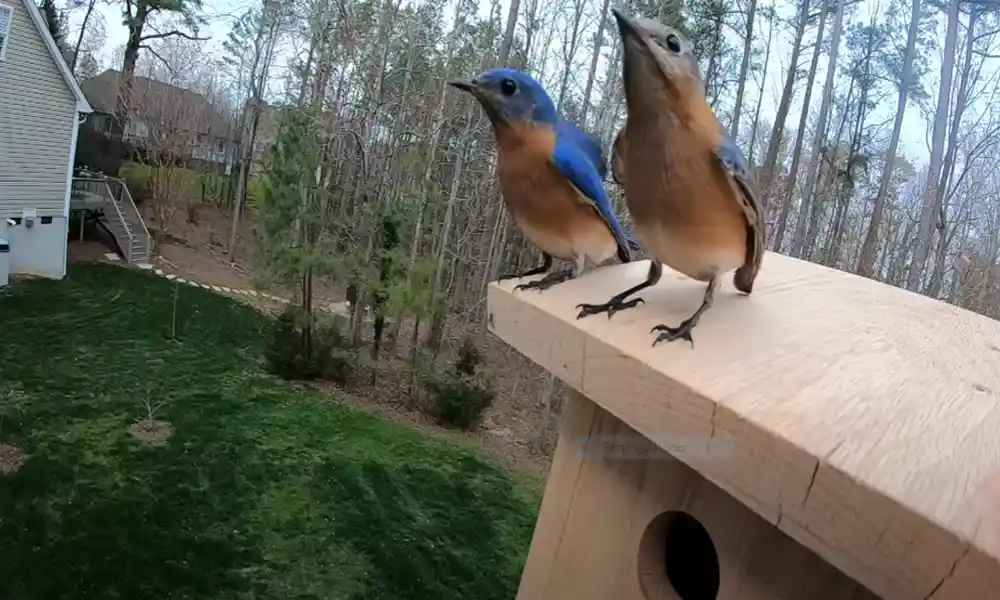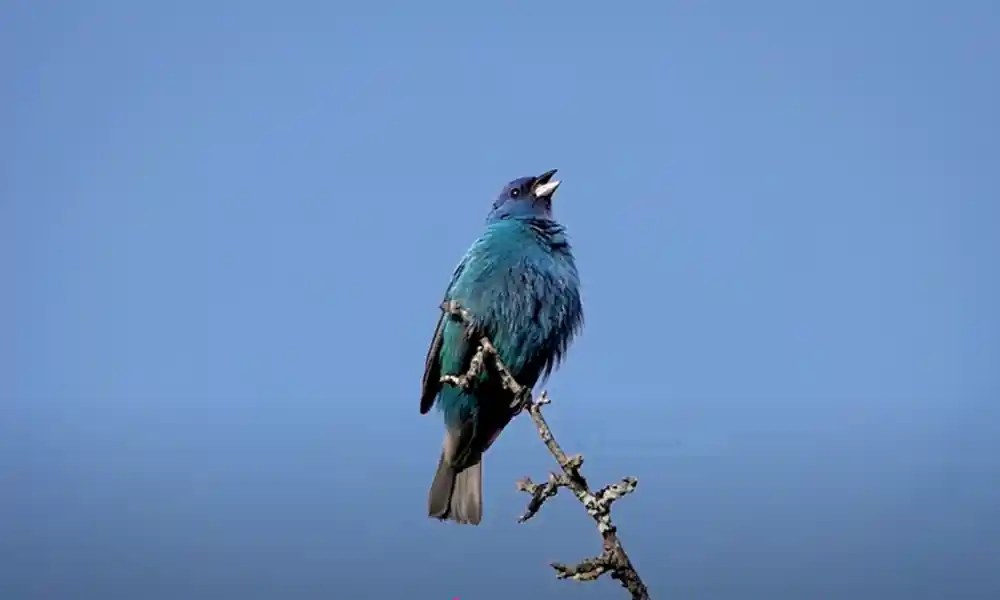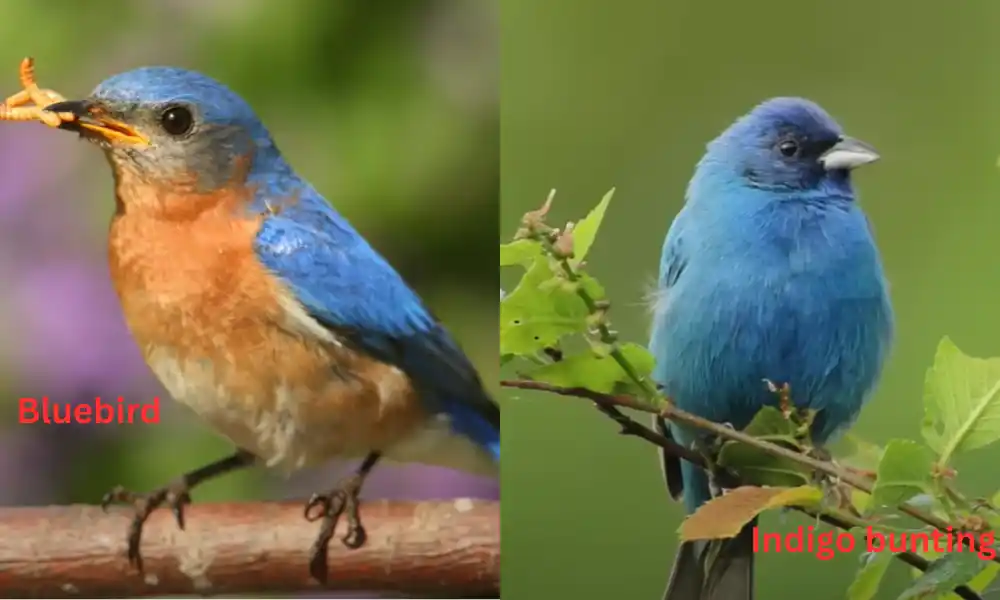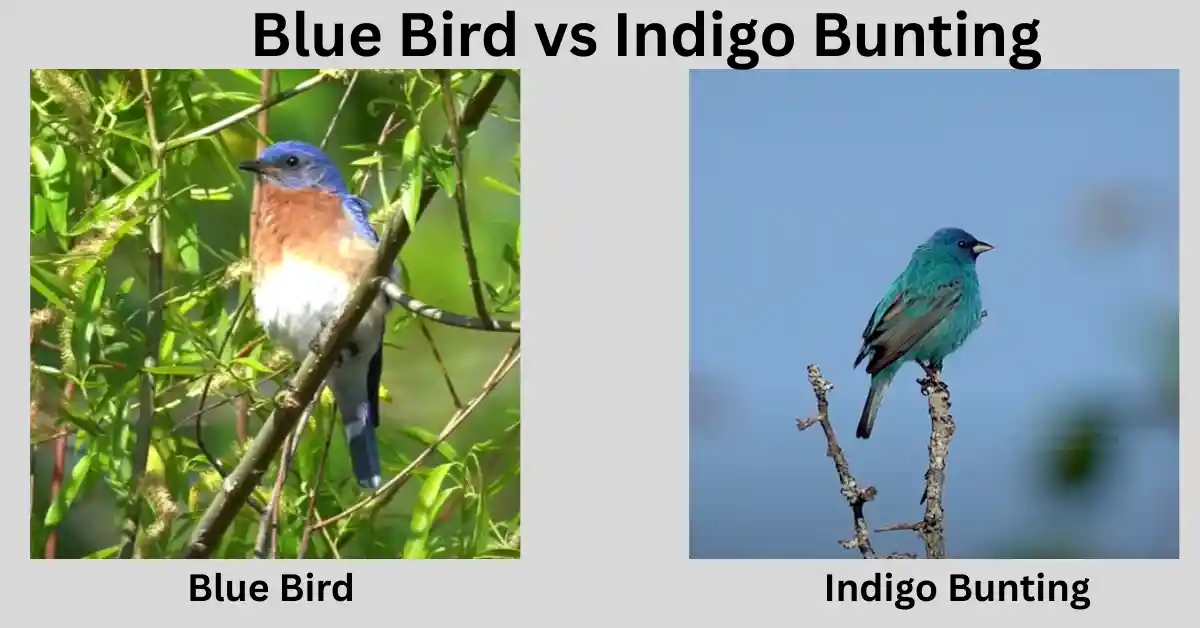I love watching birds, especially bright ones like the bluebird and indigo bunting. Their colors and songs always amaze me.
Even the blue grosbeak vs indigo bunting comparison comes up often in birdwatching chats—but today, let’s focus on the classic bluebird vs indigo bunting match-up, with some helpful pictures and personal insights along the way.
Their bright colors and sweet songs make them special. But they are not the same! From size to habitat, each has unique traits. In this guide, I’ll share what I’ve learned from my own birdwatching adventures. Let’s explore their differences together!
Table of Contents
10 Fascinating Facts
1.
Ever seen a flash of blue in the trees and wondered, “Was that a bluebird or an indigo bunting?” During my morning walks, I would constantly switch them up. But once you know the difference, it’s hard to forget.
2.
Soft blue with a rusty chest, bluebirds resemble the serene older cousin. Indigo buntings? They’re electric blue in summer, like a tiny sky on wings. Their color almost glows when the sun hits it right.
3.
Indigo buntings love to sing. I remember sitting on the porch, hearing one repeat its tune like it had something to prove. Bluebirds are more subtle, with a soft warble that feels like spring.
4.
Here’s something cool: indigo buntings fly at night and follow stars! I learned this during a night sky event—it amazed me!
5.
Bluebirds prefer open fields with trees. Indigo buntings go for brushy areas. Once I learned this, spotting them got easier.
6.
The only indigo bunting that constructs the nest and rears the young is the female. Talk about girl power in nature!
7.
Indigo buntings alternate between seeds and insects based on the season, whereas bluebirds mostly feed on insects and berries.
8.
They don’t just look different. Bluebirds are thrushes. Buntings are in the cardinal family. Surprising, right?
9.
Indigo buntings are more common in summer. That’s when their color really shines.
10.
And yes, I once mistook a young indigo bunting for a sparrow. It happens. But now? I know better.
Blue Bird: A Beautiful Companion in Nature
Blue birds have always fascinated me with their vibrant color and cheerful presence. They bring life to nature and symbolize happiness and hope. Their unique traits make them a joy to observe and learn about.

Why I Love Watching Bluebirds in the Wild
Blue birds are special for many reasons. Here’s why I love them:
- Stunning Appearance – Their bright blue feathers make them stand out in any setting. Watching them in sunlight is a magical experience.
- Melodious Songs – Their soft chirps calm the air. It feels like music from nature.
- Friendly Behavior – They are curious and often interact with humans, making birdwatching a delightful experience.
- Symbol of Good Luck – Many cultures believe blue birds bring happiness and prosperity.
- Pest Control – They eat harmful insects, helping gardens and crops stay healthy.
Their Role in Nature and Unique Personalities
While blue birds are wonderful, some aspects could be better:
- Territorial Nature – They can be aggressive toward other birds during nesting season. However, this ensures their young are safe.
- Dependent on Nesting Boxes – Due to habitat loss, they rely on human-made nesting spots. Providing one can help their population.
- Seasonal Presence – In colder regions, they migrate, making it sad when they leave. But their return marks the arrival of spring!
- Shy Around Predators – They tend to avoid areas with frequent disturbances, so creating a safe space for them is crucial.
My Personal Experience
I have been observing blue birds for years, and they never fail to amaze me. Their vibrant colors and charming songs make every encounter special.
Appearance
Blue birds are nature’s gems. Their deep blue feathers contrast beautifully with their lighter bellies. Watching them fly feels like seeing a little piece of the sky in motion.
Size
They are small but full of energy. Most blue birds measure around 6-8 inches, making them easy to spot but not overwhelming in presence. Their compact size helps them move swiftly.
Behavior & Diet
They are social but can be territorial. I’ve seen them chase away larger birds to protect their nests. They love eating insects, berries, and seeds, which makes them helpful for the environment.
Habitat & Range
Bluebirds live in fields, woods, and gardens. I’ve noticed they prefer quiet places with enough trees for nesting. They migrate to warmer regions during winter but always return in spring.
Nesting & Reproduction
They build nests in tree cavities or birdhouses. Watching them prepare a home and care for their chicks is heartwarming. The female does most of the work, while the male protects the territory.
Symbolism
Many believe blue birds bring happiness. I’ve always felt their presence brings a sense of peace. They represent hope, renewal, and good fortune.
Physical Features
Apart from their blue feathers, they have sharp beaks for catching insects. Their black eyes give them a curious look, making them even more endearing.
Types of Blue Bird
There are several species, including Eastern, Western, and Mountain bluebirds. Each has its unique charm, but all share the same captivating blue hue.
Eastern, Western & Mountain Bluebirds vs Indigo Bunting
Bird lovers often wonder how the different bluebird species compare to the indigo bunting. Eastern bluebirds, the most common, have a rich blue back and reddish chest. Mountain bluebirds are sky-blue all over, while Western bluebirds share colors with both. Compared to them, indigo buntings stand out with their deep indigo tone and smaller size. Each species adds unique beauty to the bird world.
Importance of Blue Bird
They play a vital role in nature by controlling insect populations and helping with plant pollination. Their presence means nature is in good shape.
Fun Facts About Blue Bird
- They recognize human faces and can remember friendly interactions.
- Male blue birds bring food to females during courtship.
- They can see ultraviolet light, which helps them find food and mates.
- Their blue color comes from light reflection, not pigments.
Blue birds are truly a treasure in nature. Their beauty, song, and presence bring joy to anyone who appreciates wildlife. Observing them has been a rewarding experience, and I encourage others to do the same!
Indigo Bunting: Symbolism, Song, and Stunning Plumage
The indigo bunting is a small bird with a big impact. Its brilliant blue feathers and cheerful songs make it a favorite among bird watchers and nature lovers. Let’s explore what makes this bird so special.

What I Like
- Vibrant Colors – The indigo bunting’s deep blue feathers shine like a sapphire in the sunlight. It’s a treat to see one fluttering around.
- Melodic Songs – Their singing is both calming and uplifting. It’s like having a little musician in the trees.
- Easy to Spot in Summer – They are common in open woodlands and fields, making birdwatching more enjoyable.
- Symbol of Happiness – Many cultures believe the indigo bunting represents joy and positivity.
- Friendly Presence in Gardens – They are not shy and often visit feeders, brightening up any backyard.
Their Role in Nature and Unique Personalities
- Can Be Hard to Find in Winter – They migrate south, so they’re not around all year.
- Shy Around People – Unlike some backyard birds, they may take time to trust human presence.
- Nest Predation – Their nests can be targeted by predators, making their survival a challenge.
- Not as Common in Cities – If you live in an urban area, you might not see them often.
- Can Be Territorial – Males can be a bit aggressive during breeding season.
My Personal Experience
I have been observing indigo buntings for years, and they never fail to amaze me. Their striking blue color and sweet melodies make my mornings special. Watching them in my backyard has given me a deep appreciation for their beauty and charm.
Appearance
Their blue feathers are breathtaking. In sunlight, their feathers shine bright. Males are the most colorful, while females are brownish, helping them blend into nature.
Size
They are small, about the size of a sparrow. Despite their size, they have a strong presence with their bright plumage and active behavior.
Behavior & Diet
Indigo buntings love seeds and insects. I’ve found that they enjoy sunflower seeds at my feeder. They are also energetic and always on the move, making them fun to watch.
Habitat & Range
They prefer open fields, woodland edges, and farms. I usually spot them in rural areas where there are plenty of trees and shrubs.
Nesting & Reproduction
Their nests are small and well-hidden in bushes. Females do most of the work, while males defend their territory. Watching them care for their young is fascinating.
Symbolism
Indigo buntings are signs of joy, freedom, and new beginnings. Their bright blue feathers and uplifting songs represent positivity and transformation in many cultures.
Physical Features
Aside from their striking blue feathers, they have a short, strong beak suited for eating seeds. Their small size helps them stay agile and safe from predators.
Types of Indigo Bunting
There is only one main species, but their colors can vary slightly depending on location and season.
Importance of Indigo Bunting
They help control insect populations and spread seeds, making them valuable to the environment. Having them around means a healthier ecosystem.
Fun Facts About Indigo Bunting
- Their feathers are not actually blue! The color comes from the way light reflects off them.
- They fly at night and use stars to find their way.
- Males change color slightly in the winter, becoming duller to stay safe from predators.
The indigo bunting is truly a marvel of nature. Its beauty, charm, and important role in the ecosystem make it a bird worth appreciating. If you ever get a chance to see one, take a moment to enjoy its presence!
blue bird vs indigo bunting : Detailed Comparison
I’ve been seeing bluebirds and indigo buntings for years, and they never fail to amaze me. Though both are small, vibrant songbirds, they have distinct traits that set them apart. Let’s compare them in detail.
Bluebird vs Indigo bunting pictures

Appearance: Bluebird vs Indigo Bunting
Both birds are striking, but their colors and markings differ significantly.
| Feature | Bluebird | Indigo Bunting |
| Color | Blue with a rusty or white belly | Deep indigo blue all over (males) |
| Markings | Some have white wing bars | Females are brownish |
| Plumage Change | Seasonal duller plumage | Retains blue plumage year-round |
Size: Bluebird vs Indigo Bunting
They have similar sizes but slight differences in body shape.
| Feature | Bluebird | Indigo Bunting |
| Length | 6.3-8.3 inches | 4.5-5.1 inches |
| Wingspan | 9.8-12.6 inches | 7.1-9.1 inches |
| Weight | 0.95-1.2 ounces | 0.4-0.6 ounces |
Behavior & Diet: Bluebird vs Indigo Bunting
Both birds enjoy a varied diet but have different feeding habits.
| Feature | Bluebird | Indigo Bunting |
| Diet | Insects, berries, and fruits | Seeds, berries, and insects |
| Feeding Habit | Forages on ground & trees | Primarily ground feeders |
| Social | Often in small flocks | Solitary or small groups |
Habitat & Range: Bluebird vs Indigo Bunting
They have overlapping but distinct habitat preferences.
| Feature | Bluebird | Indigo Bunting |
| Habitat | Open fields, orchards, and farms | Brushy areas, edges of forests |
| Range | North & Central America | North America & migrates south |
Nesting & Reproduction: Bluebird vs Indigo Bunting
Their nesting behaviors are quite unique.
| Feature | Bluebird | Indigo Bunting |
| Nest Type | Tree cavities, birdhouses | Bushes and low trees |
| Clutch Size | 3-5 eggs | 3-4 eggs |
| Incubation | 13-16 days | 11-14 days |
Symbolism: Bluebird vs Indigo Bunting
Both birds carry deep symbolic meanings.
| Feature | Bluebird | Indigo Bunting |
| Symbolism | Happiness, hope, renewal | Freedom, transformation, joy |
| Cultural Impact | Common in poetry & songs | Seen as a sign of inner peace |
Physical Differences: Bluebird vs Indigo Bunting
From body structure to wing shape, they have noticeable physical contrasts.
| Feature | Bluebird | Indigo Bunting |
| Body Shape | More rounded and robust | Slimmer and more streamlined |
| Beak | Slightly curved | Short and conical |
Song & Vocalization: Bluebird vs Indigo Bunting
Both birds have melodious songs, but their tunes vary.
| Feature | Bluebird | Indigo Bunting |
| Song | Soft, warbling notes | High-pitched, lively songs |
| Frequency | Sings year-round | More vocal during mating season |
Migration Patterns: Bluebird vs Indigo Bunting
While both migrate, their patterns are distinct.
| Feature | Bluebird | Indigo Bunting |
| Migration | Some migrate, some stay year-round | Migrates to South America |
| Travel Distance | Shorter distance migration | Long-distance migration |
Both the bluebird and the indigo bunting are fascinating birds with unique qualities. Their differences make them special in their own ways. Whether you love the cheerful presence of a bluebird or the striking blue of an indigo bunting, both are a joy to observe in nature.
What is the difference between a blue bird and an indigo bunting?
Blue birds have a mix of blue and rust colors, while indigo buntings are bright blue all over. They also have different songs and migration patterns.
Where can you find blue birds and indigo buntings?
Blue birds live in open fields and woodlands, while indigo buntings prefer brushy areas and edges. Both migrate, but their ranges vary.
Do blue birds and indigo buntings eat the same food?
Both love seeds, berries, and insects. Indigo buntings prefer more seeds, while blue birds eat more insects, especially in summer.
Which bird has the better song?
Indigo buntings sing fast and high. Bluebirds sound soft and calm. Both sound nice, just different!
Are blue birds and indigo buntings good for the environment?
Yes! They help control insects and spread seeds, keeping ecosystems balanced. Seeing them is also a joy for bird lovers.
Conclusion
After watching both, I can say blue birds vs indigo buntings are equally charming. Blue birds feel calm and familiar, while indigo buntings bring a flash of wild beauty. Each has its own magic. Seeing them in nature has been a joy. If you love birds like I do, take time to spot both. You’ll appreciate their unique colors, songs, and personalities!
Also Read: Egret Bird vs Crane: Key Differences You Must Know
I still remember the day that sparked my love for birds. I was just a kid, sitting in my backyard, when a tiny bird landed near me. It moved so fast, its feathers flashing in the sunlight, and then it sang—soft, clear, and almost magical. In that moment, birds became more than just creatures in the sky. They became a mystery I wanted to solve.
That curiosity never faded. It led me to study Biology at the University of Scranton, where I dove deep into the science of birds—their behavior, their calls, and the incredible ways they survive. Today, that same passion drives me, and through Earth of Birds, I get to share it with you.
Discover more from Earth of Birds
Subscribe to get the latest posts sent to your email.

